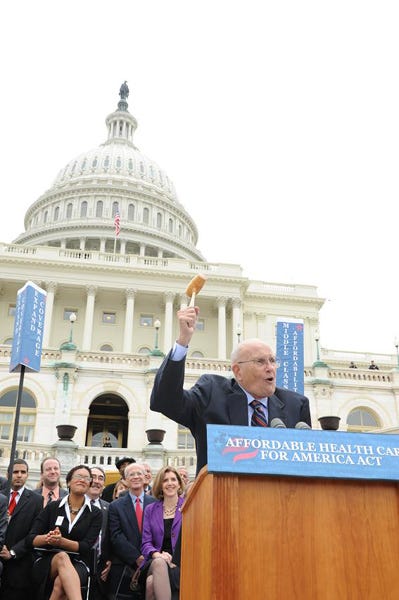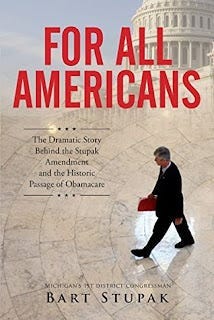In my last post, I mentioned pro-life Democrats Dick Gephardt, Dennis Kucinich, and Bob Casey, Sr. Another example is former Congressman Bart Stupak.
Bill Clinton campaigned on health care reform, but his administration failed to come up with a plan that could get through Congress, and health care reform would not receive serious consideration again at the national level until 2008. I had inadequate health insurance or none at all for much of the 90s-00s, so the issue concerned me personally.
In the 2008 presidential campaign, all of the major candidates of both parties had proposals for health care reform. I anticipated real change after Obama won, but I feared that health care reform would run afoul of abortion politics. This is in fact what happened.
Although Obama was willing to allow the existing ban on federal funding for abortions (the Hyde Amendment) to apply to his health care reform proposal in the interest of getting it passed, pro-choice members of the House rejected that approach and instead amended the administration’s proposal so that it would in effect allow federal funds to pay for abortions (the Capps Amendment). This amendment was a compromise according to its supporters, but it would have funded insurance plans that paid for abortions. This was unacceptable to pro-life representatives, including a bloc of pro-life Democrats led by Bart Stupak of Michigan. With all GOP members voting against the bill, Stupak’s bloc was able to hold up passage of health care reform in the House until the ban on funding was re-established in the legislation.
In the Senate, however, the funding ban was weakened, and when the bill came back to the House for final passage, Stupak’s pro-life Democrats faced a dilemma: allow abortion funding or kill health care reform. Obama gave them a way out: if they agreed to vote for the bill, Obama would issue an executive order that would deny the federal funding for abortions, closing the loophole in the Senate bill that allowed it. The final result was the Affordable Care Act (ACA, or “Obamacare”).
Under intense pressure, facing the defection of several members of his bloc, and unwilling to deal a fatal blow to health care reform and possibly Obama’s presidency, Bart Stupak and the remaining members of his bloc accepted this compromise.

I remember these events well. They exemplified the pernicious hypocrisy of single-issue activists and extremists on both sides of the abortion debate, but especially that of the GOP under Mitch McConnell’s leadership. Watching these events unfold solidified my conviction that another approach to abortion was needed.1
On the progressive side, some activists were concerned that women who had coverage for abortions in the health insurance plans they already had would lose it; others, it seems, simply wanted to expand access and were willing to play games with health care reform to get it. I wrote to Speaker Pelosi back then, imploring her not to allow health care reform to fail because of abortion. I asked why every other progressive goal -- everything progressives wanted to do to address health care, climate change, civil rights, civil liberties, labor, gun control, immigration, etc. -- was negotiable, but not abortion. As long as abortion remained legal, how could any progressive justify holding up health care reform, which so many people needed so desperately, in an attempt to make the government pay for abortions, which most voters opposed?
On the conservative side, the GOP showed that it was more interested in using abortion as a wedge issue than in protecting the unborn or being pro-life in the larger sense. When the Obamacare bill was in the House, the GOP representatives unanimously joined with Democrat Bart Stupak in the successful fight to maintain Hyde Amendment language in the bill, but then only one Republican, Joe Cao of Louisiana, voted to pass the amended bill. This shows that the GOP was really only interested in using abortion as a poison pill. Then, when the bill reached the Senate, the ban on federal funding for abortions was weakened by pro-choice senators. The bill could have passed the Senate with the ban intact if the GOP senators had cooperated in a bipartisan way with pro-life Democrats, but Mitch McConnell chose to pursue a path of obstructionism, and the GOP senators followed his lead.
The national pro-life organizations revealed themselves to be little better than GOP shills. They had lauded Bart Stupak when he held up passage of the ACA in the House, but when he accepted Obama’s executive order banning funding for abortions, they turned on him. Susan B. Anthony’s List had given him its “Defender of Life” award, but revoked it and donated $150,000 for advertising against him.
Pro-choice organizations were almost as hypocritical. They accused Stupak of attacking abortion rights when in fact it was pro-choice members of Congress who had unnecessarily injected abortion into the health care debate. Obama’s plan had originally been conformable to the Hyde Amendment; it was the pro-choice side who had amended the bill to include expanded abortion funding.
Catholic organizations were split. The United States Conference of Catholic Bishops had supported Stupak’s efforts but sided with the GOP in the end, despite their affirmation that health care is a right. But organizations representing Catholic sisters, many of whom work in health care, supported the passage of the ACA. Bart Stupak himself is a devout Catholic. He is pro-life in the “seamless garment” sense2; he opposed the death penalty and the second Iraq War and fought for health care reform throughout his nine terms in Congress.
It is worth mentioning that Stupak himself favored a much simpler reform plan:
. . . expand Medicaid, SCHIP, and Medicare for individuals fifty-five and over. Then, for all the rest of the uninsured Americans: allow them to buy into the Federal Employees Health Benefits Package. (Bart Stupak, For All Americans, Ch. 21, Kindle edition location 1632.)
This post is based mostly on Bart Stupak’s book For All Americans (Covenant Books, 2017), and on my own recollections of the events3. I lived in Stupak’s district from 2000-2006 and voted for him. I would encourage anyone interested in abortion, health care, or how laws are made to read Stupak’s book. Of course it is told from Stupak’s point of view, and there is some self-justification and score-settling, but it is adequately documented and its main topics are mostly matters of public record. Despite going into minute details of the legislative process and associated deal-making, I found the book to be a page-turner.
My position on abortion is what I call "pro-conscience". Briefly, the core ideas are
People can disagree in good faith about the moral status of the unborn at the earliest stages of pregnancy. In the absence of consensus, the law must respect freedom of conscience.
Past a certain point, however, the unborn deserve the benefit of the doubt and the protection of the law.
Within constitutional limits, policy disputes based on moral disagreements should be resolved by democratic processes, not judicial fiat.
In a future post, I will explain this “pro-conscience” position in more depth.
Consistent life ethic (Wikipedia)
The Seamless Garment is the Catholic position (Pedro Gabriel, Where Peter Is)




